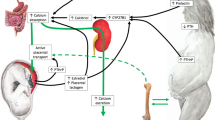Summary
Various levels of maternal caffeine ingestion during pregnancy were investigated to determine whether caffeine will affect the mineral contents of the growing bones of fetal rats. On day 8 of gestation, rat dams were fed with a 20% protein diet supplemented with 0.5 mg, 1 mg, or 2 mg caffeine/100 g of dams body weight as an experimental group and the same without caffeine as a control until day 22 of gestation. Fetuses were removed by cesarean section on day 22 and mandibular bones were removed to study the mineral contents of calcium, phosphorus, magnesium, and zinc. Although the mandible weighed more in the 0.5-mg caffeine group as compared to the controls, an additional increase of caffeine resulted in a decrease in weight. All calcium, magnesium, and zinc contents per bone decreased in the 1- and 2-mg caffeine groups as compared to either controls or 0.5-mg caffeine group, whereas phosphorus stayed relatively constant regardless of the different levels of caffeine intake. When data are expressed as per gram of bone tissue, most of the mineral contents among the groups disappeared suggesting that normal growth and development of the fetal bone are impaired as a result of maternal caffeine intake. Caffeine intake during gestation in the present study indicates that different levels of caffeine intake may exert not only different effects on mineral contents in bone development, but also affect the growth of the fetal bone.
Similar content being viewed by others
References
Dreosti IE (1982) Zinc in prenatal development. In: Clinical applications of recent advances in zinc metabolism. Liss, New York, pp 19–38
Fiske CH, Subbarow Y (1925) The colorimetric determination of phosphorus. J Biol Chem 66:375–400
Gilbert EF, Pistey WR (1973) Effect on the offspring of repeated caffeine administration to pregnant rats. J Reprod Fertil 34:495–499
Goldstein A, Warren R (1962) Passage of caffeine into human gonadal and fetal tissue. Biochem Pharmacol 11:166–168
Graham DM (1978) Caffeine — its identity, dietary sources, intake, and biological effects. Nutr Rev 36:97–102
Haydel MA, Gibbons CC, Singleton N, Kung PP (1986) The effect of caffeine on selected minerals of the rat brain. Biochem Arch 2:191–196
Heaney RP, Recker RR (1982) Effect of nitrogen, phosphorus and caffeine on calcium balance in women. J Lab Clin Invest 99:46–55
Hill RM (1973) Drugs ingested by pregnant women. Clin Pharmacol Ther 14:654–659
Kleiber M (1961) Body size and metabolic rate. In: The fire of life, an introduction to animal energetics. Wiley and Sons, New York, pp 177–216
Larvor P, Labat ML (1978) The influence of magnesium deficiency on calcium metabolism in the rat. Ann Biol Anim Biochem Biophys 18:149–155
Maor G, Silberman M (1986) Studies on hormonal regulation of the growth of the craniofacial skeleton. IV. Specific binding sites for glucocorticoids in condylar cartilage and their involvement in the biological effects of glucocorticoids on cartilage cell growth. J Craniof Genet Develop Biol 6:189–202
Munoz L, Keen CL, Lonnerdal B, Dewey KG (1986) Coffee intake during pregnancy and lactation in rats: Maternal and pup hematological parameters and liver, iron, zinc, and copper concentration. J Nutr 116:1326–1333
Nakamoto T, Shaye R (1986) Protein-energy malnutrition in rats during pregnancy modifies the effects of caffeine on fetal bone. J Nutr 116:633–640
Nishimura H, Nakai K (1960) Congenital malformation in offspring of mice treated with caffeine. Proc Soc Exp Biol Med 104:140–145
Posner AS (1973) Crystal chemistry of bone mineral. Physiol Rev 49:760–792
Spindel E, Griffith L, Wurtman RJ (1983) Neuroendocrine effects of caffeine. II. Effects on thyrotropin and corticosterine secretion. J Pharmacol Exp Ther 225:346–350
Weinman JP, Sicher H (1955) Bone and bones: Fundamentals of bone biology. Mosby, St Louis, pp 57–58
Whiting SJ, Whitney HL (1987) Effect of dietary caffeine and theophylline on urinary calcium excretion in the adult rat. J Nutr 117:1224–1228
Wong KM, Singer L, Ophaug RH (1980) Metabolic aspects of bone resorption in calciumdeficient lactating rats. Calcif Tissue Int 32:213–219
Yamaguchi M, Yamaguchi R (1986) Action of zinc on bone metabolism in rats. Increase in alkaline phosphatase activity and DNA content. Biochem Pharmacol 35:773–777
Yeh JK, Aloia JF, Semla HM, Chen SY (1986) Influence of injected caffeine on the sodium, potassium, phosphorus, magnesium, zinc and copper in rats. J Nutr 116:273–280
Author information
Authors and Affiliations
Additional information
Supported in part by a grant from the Nutrition Division of Ross Laboratories and BRSG So7 RR05704, DRR, NIH.
Rights and permissions
About this article
Cite this article
Nakamoto, T., Grant, S. & Yazdani, M. The effects of maternal caffeine intake during pregnancy on mineral contents of fetal rat bone. Res. Exp. Med. 189, 275–280 (1989). https://doi.org/10.1007/BF01852259
Received:
Accepted:
Issue Date:
DOI: https://doi.org/10.1007/BF01852259




